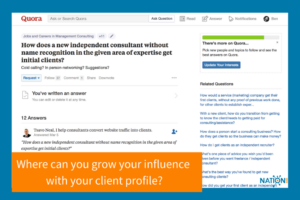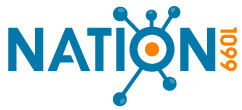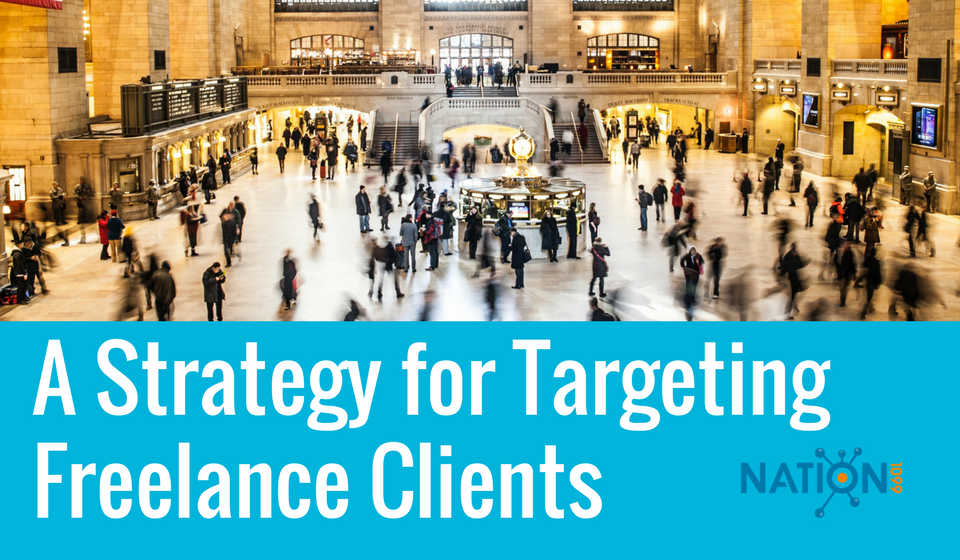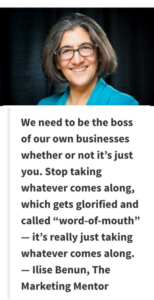What looms over a new freelancer more than anything else? I think we can agree building your client base ranks pretty highly on the list.
As individual specialists many of us know exactly how to get the job done, but aren’t quite sure how to get clients we can actually perform these jobs for.
In this post I want to tell you about one of the best and most strategic ways to overcome this hurdle. Using a client profile is the ideal top-to-bottom strategy for attracting clients — and not just any clients — the best ones you could possibly work with.
In this guide, we will explore how to define your unique client profile and a variety of effective ways you can start using yours right now to get the best clients for your unique freelance career.
Defining the client profile: start with what you have
A client profile is a specific list of characteristics that define your ideal customer — what they buy, how they act, the way they dress, and where they hang out (online and in real life). Having a conscious outline of these attributes gives you the knowledge to pursue the clients you really want in the most targeted way possible.
The best place to start with your client profile is to look at the people right under your nose — past clients, the couple you may have now, perhaps even potential clients you’d like to have.
Which qualities make some of these individuals “model clients?” Knowing what you want more of, and also what you don’t want more of are vital insights to keep in mind at all times.
Here’s a concise process for generating your client profile:
• Make a bulleted list of positive and negative traits of each of your clients — How profitable are they? How long have they stuck with you? Are they responsible? Are they pleasant to work with, and do you like the work you do for them?.
• Describe their brands — Who are they really? Which industries do they belong to? What do they look like? What do they like to do recreationally? What is their age demographic? What do they excel at? Where do they need help?
• Make a master list — Highlight the traits from your lists that most speak to your ideal client vision and consolidate them into a master list (these are their VERY best traits in your opinion, so not too many items here — and not all of your clients will have them).
Special Note: Mind the negatives — Are there common flaws these clients have that you need to look out for? Can you get the best traits of your current customers without the bad in your new clients?
• Identify the correlations — For any client you pulled a “best trait” from, include their brand summary below this master list. Look for overlap between their brand descriptions and in a few sentences describe the picture these combined attributes create. You now have your client profile.
Are you looking for ideas on how to grow your freelance career? We put together the best ideas from across Nation1099 into an ebook — 15 Easy Hacks For Finding More Freelance Clients. Even better, this ebook includes two fantastic giveaways to valuable services.
How to get clients using the client profile approach
As you can see, many elements factor into a client profile, and while each industry has its own unique kinks, certain practical factors hold true across the board — like where they live or what they like to do.
These traits can help you initiate an effective outreach strategy right away. We’ll discuss how to get clients in six powerful ways, below, based on the distinct traits of your ideal customer.
Does your client profile live near you? Find ways to connect in person

Because your client profile has pinpointed the places your dream prospects likely hang out, you can now create some valuable opportunities to connect with them in person.
All businesses benefit from expanding their networks and acquiring some new skills. Local gathering spots also like having more customers walking through their doors — this means opportunity for you.
Coffee shops, bookstores and restaurants are typically very happy to host events for other local businesses — often at no expense to the solo. So, hosting a web development explainer lunch at a trendy restaurant or bar could really pay off for your brand.
How many business owners hate the confusion of making micro changes to their websites and wish they could be more self-sufficient — just about all of them. This is a great chance to make a powerful first impression and make yourself their first call for any larger scale projects that come along.
Do this right now
- Make a list of local hangouts you’d like to host a small event at
- Make a list of local businesses you’d like to tailor the event to
- Make a list of topics for them you could easily give a casual one-hour info session on
- Send emails to/call the three places you’d most like to host your event at (as informed by the second point)
Are your ideal clients big presences in their industries? Research the conventions you know they attend

And sometimes it pays not to limit yourself just to local, in-person connections. Trade shows can be an excellent tool to meet high value industry-leading clients in an environment where they’ll be looking to make new connections. It’s also a great way to push yourself on the business development front.
Trade show directories like Events In America can be helpful for scoping out opportunities you have in your region, but it’s even more helpful to start with your client profile and follow the conventions these businesses tell you they’re attending.
Do this right now
- Make a spreadsheet of businesses that fit your client profile
- Go to 10 of their twitter pages
- Search the terms: “convention,” “event,” “trade show,” and “see you there”
- Research admission to these events
Where does your client profile live online? Engage them in their domain

Of course playing the in-person card isn’t always practical, especially in the gig economy. Many of your dream prospects will live time zones away, but this shouldn’t stop you. If you did the exercise above, then you should have a very clear sense of where your ideal clients spend their time online. You can capitalize on these insights by:
- Following prospect on Twitter and opening a conversation by responding to and sharing their tweets.
- Joining LinkedIn groups where your desired clients spend their time, and posting information, articles and your own content that might be of use to them. And do some “LinkedIn Peeping!”
- Examining potential clients’ Facebook pages and websites and offering them your recommendations in a low pressure, no-obligation consultation.
- Showing them your expertise on Quora by answering their questions or commenting on their answers.
- Finding industry-specific forums relevant to your client profile and establishing yourself within them.
Do this right now
- Search an area of your expertise on Quora — answer three questions (prioritize those asked by potential clients)
- Follow and tweet a new piece of your content to five client profile prospects on Twitter
- Visit 10 client profile pages on LinkedIn (remember, they’ll be notified and may even start a conversation with you)
Is your client not fully informed? Reel them in with excellent content
There’s nothing inherently wrong with a client that isn’t quite in-the-know. Many businesses capitalize on needs clients initially didn’t realize they had. But in this case, you need to educate your prospects.
One of the best ways to get prospects ready to hire you is to create super high value content they can download and learn from. Naturally, you’ll want to capture their email addresses so you can market to them. (We use OptinMonster to do that.)
Some of content you can develop includes ebooks, online courses, and short videos.
In these pieces of content, you tackle unique challenges or information gaps that apply directly to your client profile in a clear, educational, and non-salesy fashion. You come across looking incredibly qualified, give them information to help their hiring decision, and potentially walk away with an email address to jump-start your outreach.
Even if your client is well-informed, they probably aren’t well informed about you. This is a great chance to show them you’ve got the right stuff to help them succeed.
Do this right now
- Ask yourself what kinds of problems your client profile is most urgently struggling with
- Create an outline of topical ways you can help them with this need
- Check the demand for this solution by Googling the term and searching it on Quora
Never underestimate the power of email, but do it right

With so many avenues to pursue clients within the online space, it’s easy to forget the power of a simple email. The average person checks their email 77 times a day (!), which means you can have a serious impact on your business if you know how to get clients with a good direct outreach email.
But before you go off pitching yourself to potential clients, shift your perspective from “I” to “you.”
We live our lives in the first-person. “I will do this for you — I’m great at that . . .” In the credential-crazed gig economy, we talk about ourselves non-stop and it’s not to our benefit. Business strategist and mentor Richa Jain illustrates the problem with this kind of thinking in her recent Envato blog.
In the pitch, they [freelancers] talk endlessly about themselves, about how great they are — with statements like: “I can create a website for you. I code perfectly compliant HTML and CSS3. I know JavaScript, AJAX and PHP. As a bonus, I’ll make your site responsive.”
Does that look like a winning pitch?
Hint: It isn’t.
Successfully pitching yourself to clients means finding the meaningful intersection between their challenges and your abilities, and making the important leap to explaining exactly how your skills and planning amount to problems solved for their businesses.
Which kinds of problems does every new cafe have that you can solve? What kind of creative thinking is missing in the marketing of most tech startups? Your pitch will stand out if it focuses on specific concerns that are real to your desired clients. You may even consider interviewing some of your best clients to sharpen your understanding of these needs.
And remember — personalizing your outreach emails increases your click-through rate by 30 percent.
Is your client profile type analytical? Show them that you’re a little picky

This point applies more to the actual process of consulting with client profile prospects, but could not be more important.
If your client profile is savvy and rarely sends an email without ROI mentioned somewhere in the body, then they’re probably looking for collaborators that meet them on that wavelength.
If this client type pitches you on a project, you’ll earn their favor by showing them that you are similarly discerning and want to assess the value of the project for them before committing.
This deeply psychological method is counter intuitive, but extremely effective if carried out convincingly. Curtis McHale’s guide, “Convincing Clients Not to Do Projects (And Getting More Consulting Work),” is a must-read if this strategy speaks to your client profile.
Do this right now
- Familiarize yourself with the essential metrics for your client profile
- Email three current clients or aspirational clients and ask them specifically what a successful project result means to them
- Make a list of the 5 biggest wants your client profile has

Realize that understanding “how to get clients,” isn’t the real question
Working with a client profile saves you time and energy in attracting new customers, honing your niche, and making yourself desirable to your most relevant prospects. It shows them that you took the time to understand their needs and positioned yourself to give them the best results possible.
Client profile strategies also give you the ability to determine your own career path, by actively seeking out the precise kinds of clients you want to be doing the bulk of your work with in the future.
You can’t be everything to everyone, and you shouldn’t be. Get picky and show your dream clients that you get them like no one else can.
Stop wondering “how to get clients” and ask yourself, “how do I get the right clients?”

Ben Shanbrom is a freelance writer, musician, and copy editor who works with artists and clients within his native New Haven scene and well beyond (ask him about tracking drums in the studio where Europe recorded “The Final Countdown”). Ben is a tried and true “coffee rings on his notepad” freelancer, and wouldn’t have it any other way.













